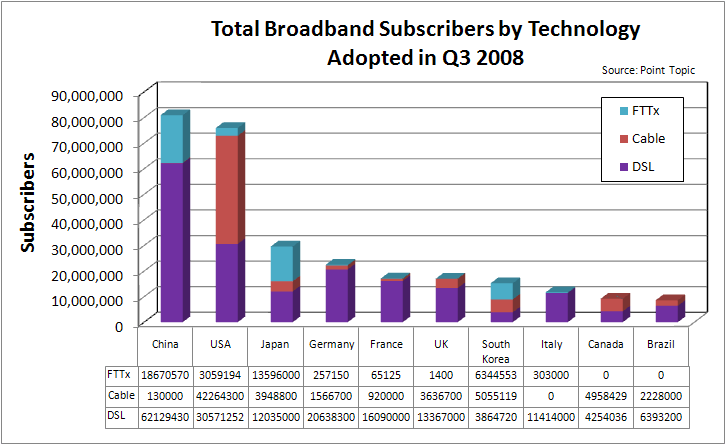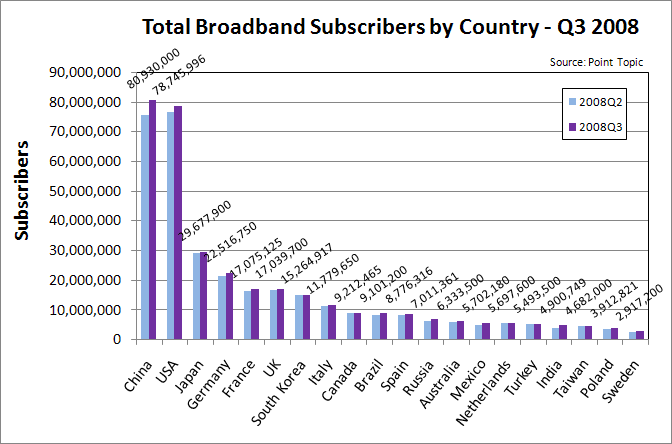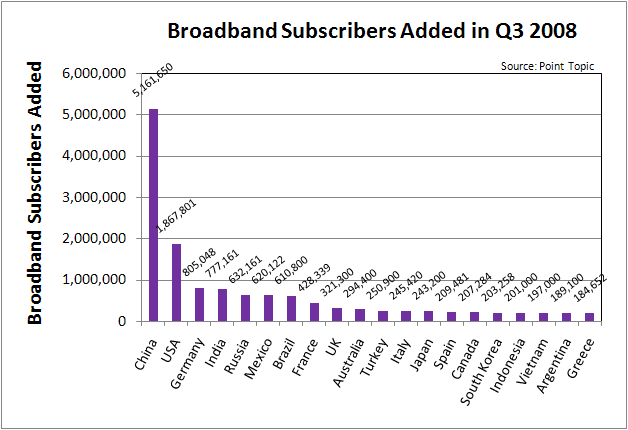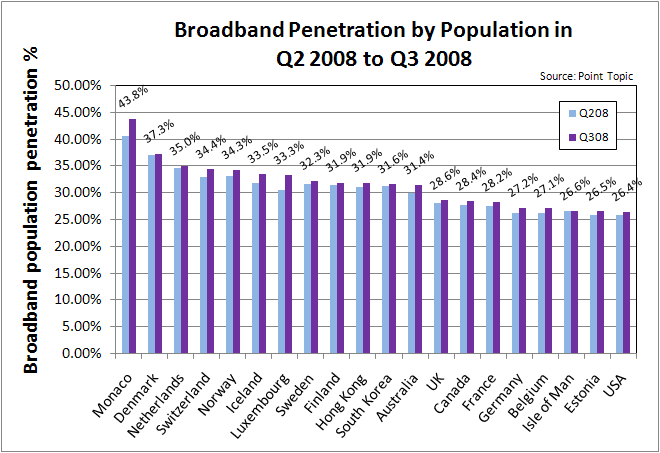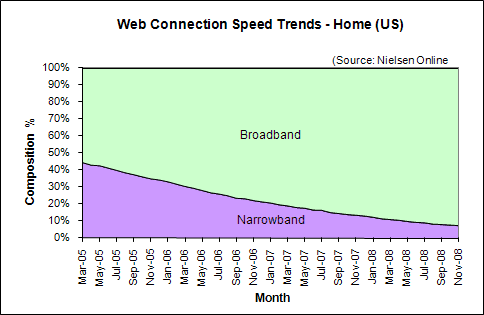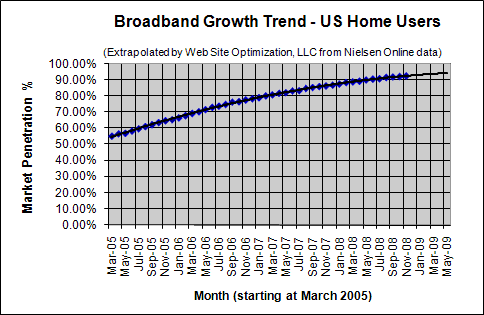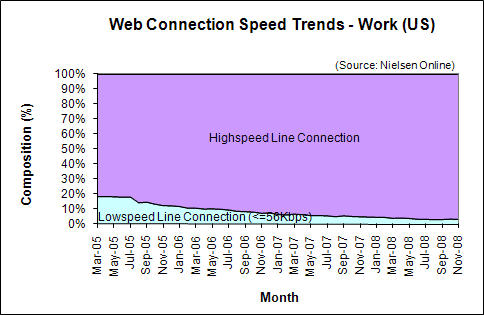President-elect Obama is calling for a massive $850 billion or more economic stimulus package to jump start the US economy and rebuild neglected infrastructure. As part of this plan the Obama administration has pledged to deploy next-generation broadband to every community in America. What the new administration has not offered is more specifics on their plan to achieve broadband for all. The Free Press has put forth a $44 billion plan to achieve universal broadband availability for the United States.
According to change.gov, the Obama administration pledges to:
“Deploy next-generation broadband: Barack Obama and Joe Biden believe we can get broadband to every community in America through a combination of reform of the Universal Service Fund, better use of the nation’s wireless spectrum, promotion of next-generation facilities, technologies and applications, and new tax and loan incentives.”
The Free Press Broadband Deployment Plan
Using a series of coordinated tax credits, incentives, grants, and appropriations the Free Press plan urges the new administration to “future proof” the new broadband infrastructure. They cite 5 Mbps as a bare minimum speed to deploy video and 100Mbps speeds to future-proof the network for next-generation applications. Some of the programs that the Free Press recommends include:
- Bonds for broadband
- Every child online
- E-rate@home program
- Lifeline/Linkup Broadband Pilot Program
- Broadband Data Improvement Act
- Rural Development Community Connect Grant Program
- Health Care and Public Service Digital Modernization Program
The spread of high-speed broadband could be a major factor in the economic salvation of the US. A 2007 study by the Brookings Institute and MIT found that for every one-digit increase in the U.S. per-capita broadband penetration rate an additional 300,000 American jobs would be created. A modest 10 point boost in US broadband penetration would mean 3 million additional jobs.
Future-Proof with Fiber
To future-proof our network we’ll need to radically change the makeup of our broadband infrastructure. The only current technology that will support symmetric 100 Mbps speeds is fiber. The US is well behind leading countries in fiber penetration, which reduces our average download speed. The median download speed of the United States is from 2.3 Mbps to 8.9Mbps, compared to that of Japan at 63 Mbps to 93.7 Mbps, some 10 to 27 times faster. Estimates range from as low as 3% of all broadband connections in the US are on fiber to as high as 4% on fiber (see below). In contrast, leading countries have from 23.1% to 45% of broadband subscribers due to fiber. Japan (45%), Korea (39%), and China (23.1%) have the largest share of broadband subscribers on fiber, some 5 to 15 times more fiber subscribers per population than the US. The Free Press study found China with 23.1% of broadband connections due to fiber, nearly 6 times the US rate of 4% (see Figure 1).
Figure 1: Broadband Subscribers by Type – Top 10 Countries
Source: Point Topic
China Passes US in Total Broadband Subscribers
While China, Japan, and Korea have faster broadband speeds than the US, in the last quarter China has passed the US in the number of broadband users (see Figure 2). The total number of Chinese broadband subscribers is growing at a rate of 6.8% per quarter, some 2.8 times greater than the US at 2.4% over the last quarter (see Figure 3).
Figure 2: Total Broadband Subscribers by Country – Top 20 Countries
Source: Point Topic
Significantly, 23.1% of Chinese broadband households use fiber while 4% of the US are on fiber (see Figure 1). The US relies on cable to provide more than half of their broadband subscribers (42 million or 55.7% of all subscribers) with 40.3% on DSL and 4% on fiber. By contrast, China has 76.6% of broadband subscribers on DSL, while 23.1% are on fiber and only a small percentage (0.16%) are on cable.
Figure 3: Broadband Subscribers Added by Country – Top 10
Source: Point Topic
This “fiber deficit” is limiting the maximum speeds that US broadband subscribers can realize. In order to improve the average speed of US broadband, the US needs to deploy higher speed technologies such as fiber, rather than make cable or DSL more universally available. China, Japan, and Korea have a speed advantage of from 10 to nearly 30 times over the US due mainly to our reliance on cable broadband connections.
US Falls to 20th in Broadband Penetration By Population
Once again, Monaco leads all countries surveyed in broadband penetration with 43.8% on broadband. Denmark (37.3%), the Netherlands (35%), Switzerland (34.4%), and Norway (34.3%) follow (see Figure 4). The UK came in 13th overall in broadband penetration at 28.6%. Canada followed at 14th with 28.4% of the population on broadband. The US dropped to 20th at 26.4% penetration, behind tiny Estonia. The US has fallen from 19th to 20th place in broadband penetration since the second quarter of 2008.
Figure 4: Broadband Penetration by Population by Country top 20 countries Q2 2008 to Q3 2008
Source: Point Topic
Home Connectivity in the US
US broadband penetration grew to 92.42% in November 2008. Dial-up users connecting at 56Kbps or less now make up 7.58% of active Internet users,
down 0.34 percentage points from 7.92% in October 2008 (see Figure 5).
Figure 5: Web Connection Speed Trends – Home Users (US)
Source: Nielsen Online
Broadband Growth Trends in the US
In November 2008, broadband penetration among active Internet users in US homes grew by 0.34 percentage points to 92.42%, up from 92.08% in September. This increase of 0.34 points is less than the average increase in broadband of 0.47 points per month over the last six months (see Figure 6). Broadband growth appears to be slowing down in the past few months as penetration reaches saturation, at least among active Internet users.
Work Connectivity
As of November 2008, 96.54% of US workers connected to the Internet with broadband, up 0.12 percentage points from the 96.42% share in October. At work, 3.46% connect at 56Kbps or less (see Figure 7).
Figure 7: Web Connection Speed Trends – Work Users (US)
Source: Nielsen Online
Further Reading
- Down Payment on our Digital Future: Stimulus Policies for the 21st Century Economy
- This document presents a $44 billion stimulus plan to revamp the United State’s broadband infrastructure. “Just as President Eisenhower’s economic policies brought Americans a national transportation system in the 1950s, President Obama’s can connect Americans to a communications network fast becoming the foundation of the 21st-century economy.” S. Derek Turner, Free Press, Dec. 2008.
- Nielsen Online
- Provided the US broadband penetration data for active Internet users for the Bandwidth Report.
- Obama’s broadband roadmap
- This story from the Huffington Post cites the Brookings Institute study that found that for every one-digit increase in the U.S. per-capita broadband penetration rate an additional 300,000 American jobs would be created. Reclaim the Media, December 10, 2008.
- Point Topic
- Provided the worldwide broadband data for the top 20 countries for the Bandwidth Report.
- UK to pass Canada in Broadband Penetration in 2008
- This October 2008 Bandwidth Report shows the US at 3% for fiber broadband connections, from the OECD.
- US Drops to 19th in Broadband Penetration Worldwide
- The September 2008 Bandwidth Report has the Q2 2008 data from Point Topic for comparison.
- US Needs Broadband Czar Says FCC
- This June 2008 Bandwidth Report shows the order of magnitude difference in broadband speeds between Japan and the US. The U.S. is at 8.9Mbps while Japan’s average download speed 93.7Mbps, more than 10 times faster.

